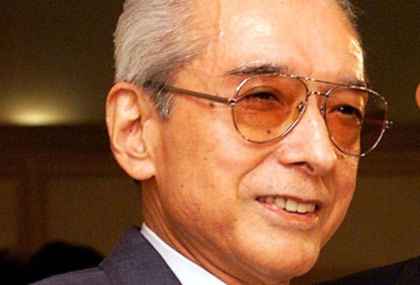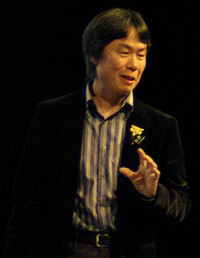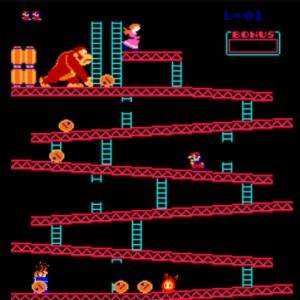| Super Mario - Nintendo Goes Forward |
| Written by Historian | |||
Page 1 of 2 Nintendo graduated from a playing card manufacturer to a games console maker but where to go next? The answer was into software and so Mario was born. We outlined the start of the Nintendo story in Nintendo -The Early History and now we continue the tale ... With the success of the Famicom games console Nintendo had a winner - but it also had a problem. In the games market it isn't hardware that is of interest. A company makes a profit on selling the hardware but it makes repeated profits on selling the games cartridges that are needed to feed it. The games are where the profits are and games sell the hardware in the first place. Without compelling games the Famicom would have been doomed to sink without trace - but with Donkey Kong and Mario to help there was no need to worry. But how did Nintendo manage to create these now classic games without any track record in computing and only a short history of creating games and novelties?
Hiroshi Yamauchi, born 1927
Hiroshi Yamauchi, the head of Nintendo, had never played a computer game in his life and yet he was judge and jury for all of the games in production. He was criticised for his ruthless attitude and seemingly arbitrary decisions. Yet over time he seems to have had an uncanny knack of choosing winners. Such luck is rarely just luck and, if you look closely, Yamauchi actually had a clear understanding of the problems and requirements. He said "an ordinary man cannot develop good games no matter how hard he tries. A handful of people in the world can develop games that everybody wants. Those are the people we want at Nintendo". Hiroshi encouraged the artist, the hacker and the enthusiast and his whole approach wasn't what we think of as typically Japanese. His three R&D groups worked in a spacious laboratories and Hiroshi said they were the hardest to manage. He sent burnt out engineers on sabbatical with the advice "come back fresh". He ruled with absolute power and his engineers tried hard to win favour. The three R&D groups had specific areas of interest. R&D 1 designed the Gameboy and many successful games. R&D 2 designed the Famicom and many of its peripherals. R&D 3 created games and improved the cartridges to run them. One day Hiroshi needed an engineer for a relatively low level job and there was no one free in any of the three research groups. He picked on Shigeru Miyamoto, an apprentice in the planning department for the job. The job was converting a failure of a game - Radarscope - to something better. Miyamoto would have the help and advice of the boss of R&D 1 but essentially he was on his own.
Shigeru Miyamoto
Miyamoto was born in 1952 in a small town near Kyoto. His family didn't have a TV or a car but they did go to the big city to shop and see movies. Miyamoto read books and became deeply absorbed in fantasy and theatre. He made puppets and wanted to be a painter. He carried a pad of paper everywhere and drew cartoons. He took longer to graduate because of his addiction to drawing but eventually he did face the problem of finding a job. He asked his father to contact his friend Hiroshi Yamuachi. Hiroshi was sceptical "we need engineers not artists" - but he still agreed to meet. He was impressed by the young Miyamoto and asked him to return for another meeting with ideas for toys. After seeing some designs he hired him as the company's first staff artist - even though it didn't need one and didn't have an art department - and so he was actually assigned as an apprentice to the planning department.
Birth of a Super HeroIn 1980 Miyamoto was finally called into Hiroshi's office to be offered the chance to design a game. He gave his opinions of the shoot'em ups - crude and boring. Why didn't games employ more of the story line and techniques that made cartoons popular and absorbing. But his task was to make something out of Radarscope - one of the most banal of games. Planes came into view and players had to shoot them down. He asked questions of the technicians about how the characters could move and decided to abandon Radarscope and start again - which is a very broad interpretation of the instruction "to improve something". Nintendo was negotiating to use the Popeye characters and Miyamoto started work on a game based on them. The deal fell through and he had to start again. Beauty and the Beast was one of his favorite stories so he tried to create characters based on this. He imagined a bad guy, vaguely gorilla like but not too evil. The gorilla stole the girl friend of the hero and the object of the game was to get her back. The hero was a brightly overalled carpenter - at the time a very strange choice. Even more strange was the name he chose for the game - Donkey Kong. The name would later make an American sales manager resign in despair - games had names like killer or annihilator or ... well anything thing but Donkey and Kong in combination.
Donkey Kong
What makes the story all the more amazing is that Hiroshi Yamauchi heard all of the negative comments and still backed it. In 1981 Nintendo released Donkey Kong and it became the first smash hit game. Miyamoto was promoted to head of R&D and asked to produce more games like Donkey Kong. He began sketching his previous hero and someone said that he looked more like a plumber - Mario was born and his brother Luigi soon followed. Luigi was tall and thin to make sure that he was instantly distinguishable. The new game - Super Mario Bros - had all of the elements that Miyamoto enjoyed. He borrowed from Star Trek with warp zones, took magic mushrooms from Alice and included strange happenings to keep players interested. Miyamoto was fascinated by tunnels, manholes and the possibly of change. Between 1985 and 1991 eight Mario games were produced and 60 to 70 million were sold. For a retrospective here's a video that we used to celebrate Super Mario's 25th birthday: <ASIN:1591845637> <ASIN:178239527X> |
|||
| Last Updated ( Saturday, 16 March 2024 ) |



